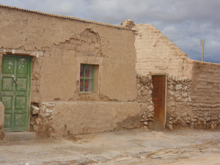Article
Adobe is made of clay soil mixed with water and straw that is then formed into walls, oblong shapes, hornos (ovens), or bricks. The finished object is left to dry and harden in the sun. Once cured, it is covered in a coat of plaster, which is essentially thinned adobe mixed with lime.
The word adobe originated in Arabic, and was used by the Spanish to refer to mud brick structures. Adobe was incorporated into English in the 18th century, and the term has come to mean not just the building material but also an architectural style popular in the Southwest, U.S. particularly in Arizona and New Mexico. The use of adobe in New Mexico can be traced to many centuries prior to European contact and was widespread among various Native American groups, especially the Puebloans. With the arrival of Spanish explorers and settlers, local building techniques were combined with Spanish architectural styles to create what is now referred to as the Santa Fe or Spanish-Pueblo Revival style, made famous by the rise of Santa Fe, NM as a popular tourist attraction and cultural center.
"House of adobe bricks covered with authentic adobe plaster, February 7, 2011" by psyberartist is licensed under CC BY.
Manuscripts
References
Encyclopedia Britannica Online
2013 Adobe. http://www.britannica.com/EBchecked/topic/6203/adobe, accessed
February 25, 2015.

